Key takeaways.
-
How big is a psilocybin microdose?
A microdose contains anywhere between 25mg (0.025g) and 300mg (0.3g) of dried magic mushrooms.
-
How big is a psilocybin minidose?
A minidose contains anywhere from 0.3g – 1g of dried magic mushrooms.
-
How big is a psilocybin macrodose?
Anything over 1g is considered a macrodose and produces potent psychedelic effects.
-
How do you know how much to take?
Check out the article for detailed information on each dose and how and what it might be used for to get an idea how much is the best dose for you.
The world is opening up to magic mushrooms, and Canada is in the lead. But before you go shrooming, you need to know how.
Magic mushrooms are powerful. Apart from the fact that it can be hard to navigate a too-high dose if you’re not ready for it, they can be used for a range of things and for a variety of effects.
This often relies on dosage, although strain can play a role.
Magic mushroom dosing starts at a microdose — as low as 25mg (0.025g) of dried Psilocybin mushrooms — and goes up to what Terrence McKenna calls a “heroic dose” of 7g and above.
We don’t advocate aiming for heroic doses until you’re a well and truly seasoned mushroom user. This guide is going to help you choose the right dose for where you’re at in the mushroom adventure.
This guide is separated into two parts.
The first covers everything you need to know before choosing your dose:
- What are magic mushrooms?
- What is the active compound in magic mushrooms?
- How much psilocybin is in magic mushrooms?
- Do mushroom caps or stems have more psilocybin?
- How to choose a magic mushroom strain to dose with.
- Should I adjust the dose for my weight?
- How to take magic mushrooms.
- Different ways to consume magic mushrooms.
The second covers the different dosages and their effects:
We’ll guide you through the different dosing regimens and the recreational and therapeutic goals they can be used for. Where you choose to start is up to you and will depend on your experience and confidence using psychedelic plants. As a disclaimer, using mushrooms is not the same as using cannabis. We recommend that first-timers start microdosing with doses as low as 0.025g (25mg) and macrodosing with doses as low as 0.5g (500mg), and work THEIR way up from there.
What are magic mushrooms?
There are over 200+ species of Psilocybin mushrooms, or magic mushrooms, most of which belong to the genus Psilocybe. These fungi are capable of producing psilocybin, a compound that produces psychedelic effects and is being lauded by the medical, biohacking, fitness, tech communities, and more as a breakthrough in human optimization and healing.
Clinically, it's touted for its therapeutic uses for a variety of conditions, including depression, anxiety, PTSD, addiction, and ADHD. Non-clinically, it's used to enhance mood, productivity, cognitive function, athletic performance, and more.
Indigenous cultures have been using magic mushrooms for thousands of years as part of their spiritual and medicinal practices. So, while it may seem like there is a renaissance of spirituality, optimization, and healing in the Western world, psilocybin mushrooms have a long-existing place in indigenous cultures' mind-body-spirit healing practices.
What is the active compound in magic mushrooms?
The most abundant psychoactive compound found in magic mushrooms is psilocybin, which is metabolized in the body and converted into psilocin. Other compounds found in magic mushrooms include psilocin and baocystin. There are more, but we've yet to discover their clinical significance.
While we love talking about psilocybin, it is not in fact the main psychoactive compound in magic mushrooms. It is what’s known as a prodrug: A biologically inactive compound that can be metabolized by the body to produce an active drug.
Instead, psilocin is the real star of the psychedelic fireworks show. Your body produces psilocin when it metabolizes the psilocybin in the magic mushrooms you consume. Psilocin is the active compound that causes psychedelic effects. These effects come from psilocin’s resemblance serotonin, a neurotransmitter in the brain, primarily the PFC, that regulates mood, memory, and executive function. Learn more about how magic mushrooms affect the brain here.
But how much psilocybin is actually found in the most common Psilocybe species, and how should you think about dosing dried magic mushrooms or psilocybin-containing products?
How much psilocybin is in magic mushrooms?

Like cannabis plants, the chemical profile of magic mushrooms varies across species and variations within those species, which we typically refer to as strains. In the graph above, each bar represents the average total psilocybin content for different species of Psilocybe mushrooms, and the horizontal capped lines on each bar represent variance within that species' samples. Data were compiled from Study 1, Study 2, and Study 3.
As the graph illustrates, two mushrooms can produce different psilocybin levels, even if they're from the same species and harvest. Lab testing is the only way to know precisely how potent a given mushroom is.
Do mushroom caps or stems have more psilocybin?
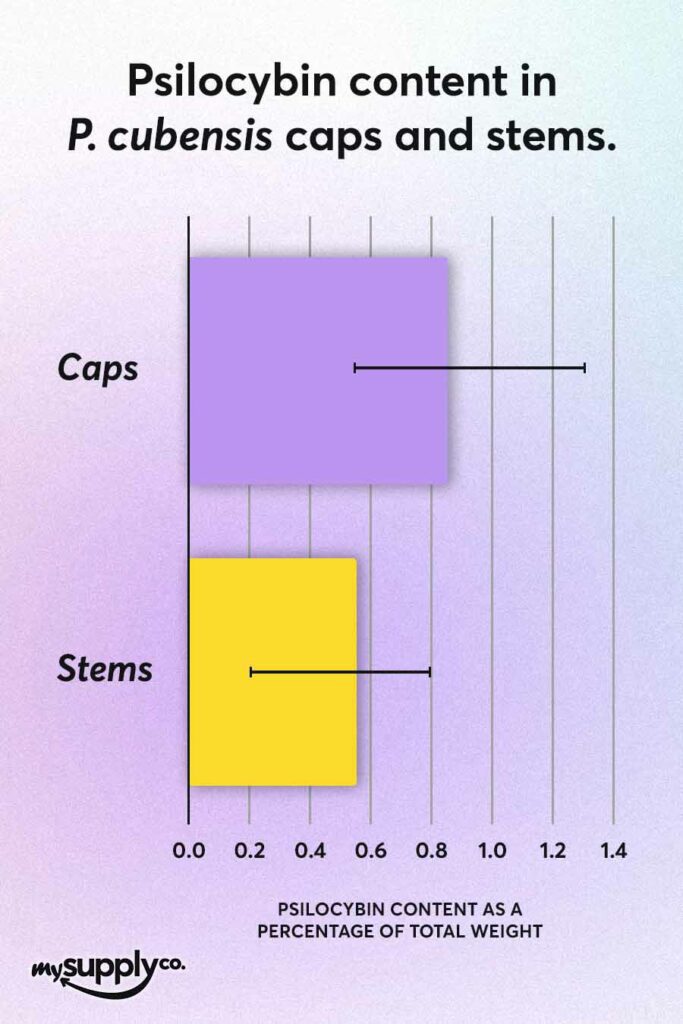
The graph above shows the average amount of psilocin in both the caps and stems of Psilocybe cubensis samples. The vertical lines on each bar indicate the standard deviation, or how close or far apart a group of things are from the middle.
On average, the caps have higher total psilocin levels, but there's a significant variation from one sample to another. Some people believe that either the caps or the stems of magic mushrooms are more potent.
Limited published data is available on this matter. By combining data from a 1982 study and a more recent 2003 study, we find that, on average, P. cubensis caps tend to contain more total psilocin than the stems. However, there's a notable degree of variability among samples, and there's considerable overlap between the psilocin content of caps and stems. As a result, it's not a very reliable rule to determine potency. Further research is needed to better understand this topic.
How to choose a magic mushroom strain to dose with.
Despite the variation found between species and strains, there is some published data on the psilocybin content of common Psilocybe mushroom species and we can use this to inform dosing guidelines.
The most common species of magic mushroom is Psilocybe cubensis. Published research on the psilocybin content of Psilocybe cubensis mushrooms has shown that they can contain roughly 0.5 – 1.0% total psilocin, averaging around 0.7% by weight; 0.7% total psilocin equates to about 1% psilocybin.
In addition, the commercial cultivation of popular strains like Golden Teacher mushrooms from the Psilocybe cubensis species has led to a relatively standardized percentage of psilocybin, as long as you get it from a reputable source like My Supply Co.

Should I adjust the dose for my weight?
In 2021, an analysis to find out if your body weight affects your psilocybin experience was published in the Journal of Psychopharmacology. In the analysis, researchers looked at data from ten studies involving 288 people who received psilocybin at doses between 20 and 30 mg for every 70 kg of their weight.
The researchers were investigating if body weight or gender had any impact on how you experienced psilocybin, and split participants into three groups: one received 20 mg/70 kg, another 30 mg/70 kg, and the last had a dose adjusted to around 25 mg (similar to what's being studied for depression).
The results showed that in all three groups, there wasn't a clear connection between your body weight and how psilocybin may affect you. So, taking psilocybin as a fixed dose is practical and cost-effective and works just as well as adjusting the dose based on your weight.
Instead of focusing on adjusting your dose to your weight, start with low doses and work your way up as you familiarize yourself with the psychedelic landscape and develop the tools to manage the experience as best you can.
And when it comes to finding your psilocybin dose, we recommend working with a trusted psilocybin therapist for optimal growth, healing, and transformation.
How to take magic mushrooms.
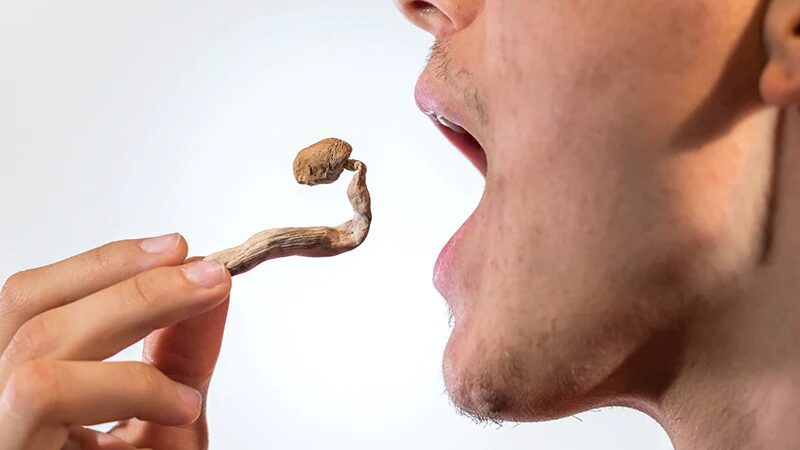
As always, the mantra for trying a new psychoactive drug is: “Start low, go slow.” Aside from a micro-dose, start with no more than one gram of dried mushrooms, or 10 mg of psilocybin. You can increase your dose every 25 minutes or so.
Only experiment with higher doses once you feel comfortable at a low dose.
It’s also important to take psilocybin in a safe, comfortable setting, preferably with someone to watch over you or even professional human support in case of any difficulties, as was the case in the Johns Hopkins studies. The experiences one might have with psilocybin or other psychedelics are very sensitive to your mental and physical state, and environment—what’s known as “set and setting.”
Once you get into the “medium dose” range or higher, it’s important to be extra mindful of what you’re dealing with. Remember: you may never be the same again. Patients from the Johns Hopkins studies often reported their 20-30 mg experiences to be among the most important of their lives, comparable in significance to the birth of their first child.
Different ways to consume magic mushrooms.
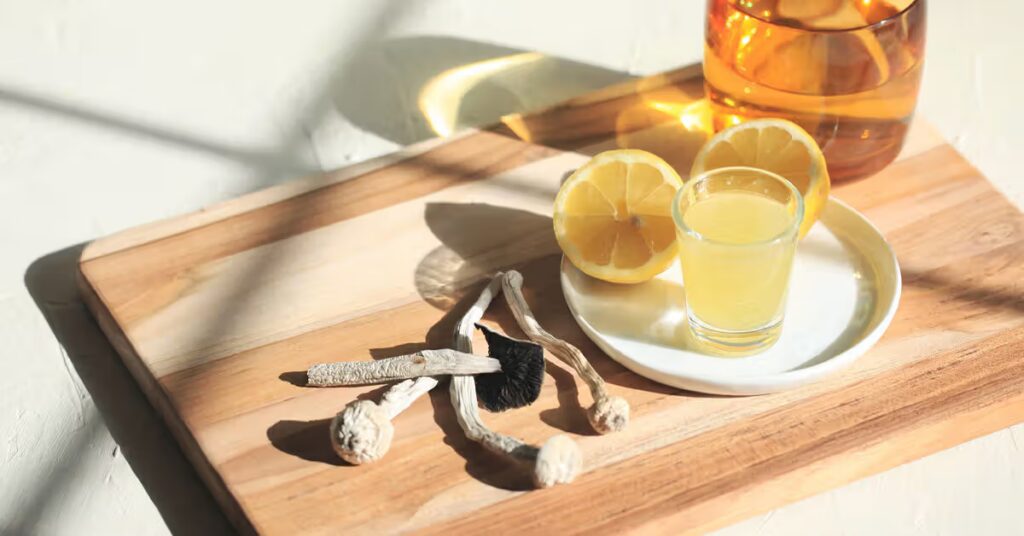
Brownies, gummies, chocolates, teas, coffees, capsules, soups, PB&J sandwiches—there are more ways to consume magic mushrooms than you can imagine. Whatever your preference is, there's a way to satisfy it.
If your goal is to have an easy-to-dose on-the-go way to microdose, we recommend gummies and capsules. You can make your own gummies by following this simple recipe. You can also purchase one of our microdose supplements, which come with 25mg per capsule plus nature's most potent mushrooms, adaptogens, superfoods, and vitamins.
If your goal is to have an indulgent way to macrodose, we recommend our Psilocybin macrodose supplements, or making your own magic mushroom brownies, chocolates, and teas. We recommend you follow this simple recipe for the fudgiest frosted magic mushroom brownies, and this recipe for making your own mushroom tea.
If you're looking for a way to reduce nausea, the onset time, or trip duration, we recommend the lemon tek method. But we would never recommend lemon tekking to a novice because it can intensify the trip by 2 - 3 times. When you add that to the fact that it has an almost immediate onset, it can be a pretty jarring and scary experience for somebody who is just starting their journey with psychedelic mushrooms. Brewing your own magic mushroom tea can also help reduce the nausea.
What effects will different doses of psilocybin have?
Let's imagine you have a batch of magic mushrooms with 1% psilocybin. How many mushrooms, measured by weight, would you need to consume for mild, moderate, and intense effects?
In the following sections, we'll break down the psilocybin content across a range of doses, from microdose to heroic dose, and explain the possible effects for each level, drawing from both reports of experienced psychedelic users and findings from human clinical trials.
Microdose: 25mg – 300mg (0.025g – 0.3g)
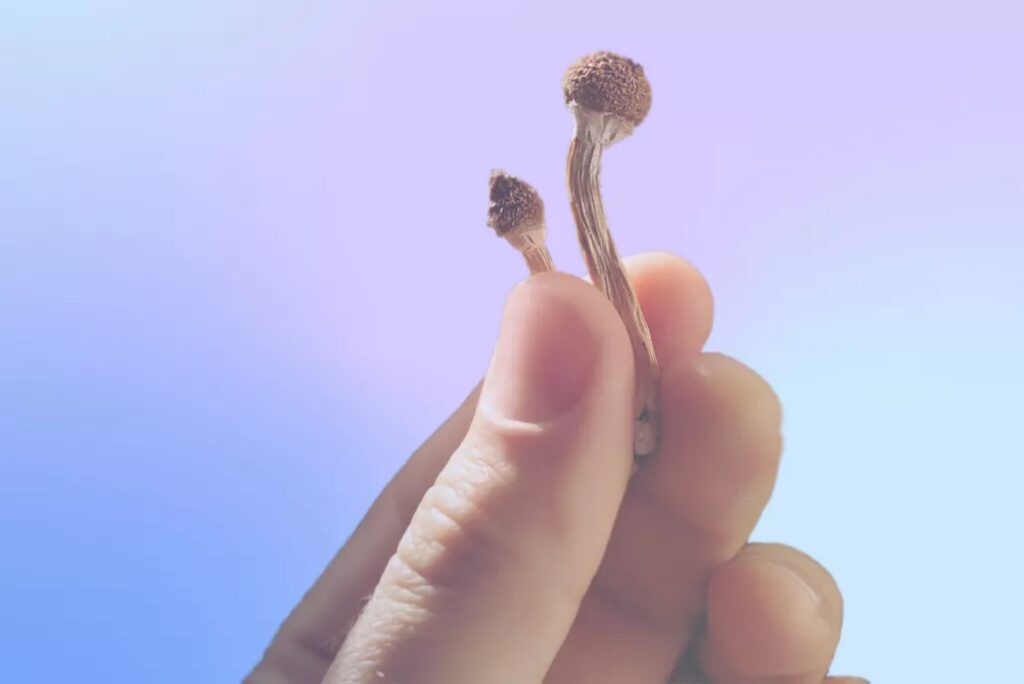
Microdosing is a way of using mushrooms that doesn’t necessarily bring about any psychedelic effects and is often referred to as sub-perceptual. However, to call it sub-perceptual is incorrect. There will and should be some perceptual changes, but nothing that would constitute a trip. Instead, your visual and auditory acuity will increase, and you'll feel a gentle euphoria and lift in your mood.
Microdosing is taking mushrooms but not tripping. There’s no definitive rule on what defines a microdose. However, it can be as low as 25mg (0.025g) or as high as around 0.3g. Anything above 0.3 brings on perceivable effects.
And while there's no definitive rule on how often you should microdose, there are a few agreed-upon best practices:
- You cannot microdose every day. You will build up a tolerance and stop getting the full benefits from the doses you're taking. That's why every established microdosing protocol has small 1 - 3 day breaks between microdose days, and longer breaks after every 4 - 8 weeks of microdosing.
- Document. At first, you will feel a difference in your overall sense of well-being between microdose and non-microdose days. As time goes on, you will be less conscious of this difference. This could be because your microdoses aren't as effective, meaning you should take a tolerance break. But more likely, your overall well-being has improved, regardless of whether you're microdosing or not.
The recreational benefits of microdosing include cognitive benefits like improved memory, mood, focus, clarity, and drive, as well as potential physical benefits like improved neuroplasticity, mind-body connection, gut health, brain health, and physical performance.
Therapeutically, clinical studies, online forums, and our customers swear by microdosing's ability to alleviate or soften the symptoms of mental health conditions like anxiety, depression, PTSD, ADHD, and more. Many also report being able to wean off their meds, or put their conditions into remission.
Check out this video by our Head of Marketing and Product Education for a quick overview on the science and benefits of microdosing Psilocybin, along with tips on how to microdose effectively.
How to Microdose Magic Mushrooms: Protocols, Dosages, and Research-Backed Benefits by @MySupplyCo
True Microdose: 25mg – 100mg (0.025g – 0.1g)
Almost completely sub-perceptual effects with very little chance of tipping over into a tripping state.
Unless you have the most sensitive scales in the world, it’s unlikely that you’ll ever be able to weigh out less than 0.05g magic mushrooms. To solve that problem, our microdose supplements start at 25mg Golden Teacher per capsule to offer you the ultimate flexibility. This is a good microdose starting point for those who are just experimenting.
With a true microdose, you might perceive:
- Heightened creativity
- Increased energy, focus, and attention
- Increased mood, restfulness, peacefulness, calm
- Better memory and cognitive performance
- Increased physical and emotional comfort
Medium Microdose: 100mg – 200mg (0.1g – 0.2g)
Yes. A difference this small makes an impact when it comes to microdosing. Even the tiniest increments can bring on more pronounced effects. This is still considered a microdose event and isn’t likely to cause serious tripping.
With a medium microdose, you might perceive:
- Heightened creativity and mental activity
- Increased focus, attention, and pattern recognition
- Improved mood, heightened perception of the mind and emotions
- Quick mental performance
- Improved physical performance
Strong Microdose: 200mg – 300mg (0.2g – 0.3g)
This could easily turn into a light tripping experience so it’s not typically recommended as a microdose. However, it’s low enough not to be full-on tripping for most people, so for seasoned microdosers it could be considered.
With a strong microdose, you might perceive:
- Altered visual and physical perception
- Heightened attention to detail
- Increased mental dexterity and problem solving
- Improved mood, energy, and increased perception of thoughts and emotions
- Abstract thoughts
What is a minidose?

Minidosing means you’ve stepped out of the world of sub-perceptual effects and into the realm of true mushroom effects. You could say that from here, we’re really just talking about different levels of intoxication (although potency does vary quite a bit with mushrooms).
Minidosing is a perfect place for beginners to start tripping. Essentially, starting on lower doses completely minimizes the chances of an anxiety-filled, way-too-strong first mushroom experience that ends in you hating mushrooms. We’ll break it down into different levels for you.
True Minidose: 300mg – 500mg (0.3g – 0.5g)
This is a very safe place to start for beginners. At this dose, visual perception becomes noticeably different and the world might start to become “trippy”. Thoughts can become introspective and existential, or deep abstract concepts can be entertained. At the same time, this is not the kind of journey that leads to ego death or a loss of motor control.
With a true minidose, you might perceive:
- Mild euphoria or excitement
- Changes in visual perception (lights, vivid colours, movements)
- Changes in the way things sound and feel physically
- Heightened physical senses
- Mundane tasks suddenly become more engaging and exciting
- The arts are highly engaging, especially music and visual art
- A preference for introspection over social activity
- A desire to stretch or flow
- Increased creativity, mental acuity and pattern recognition
Museum Dose: 500mg – 1,000mg (0.5g – 1.5g)
As the dose gets stronger, the effects all become more prominent. Dr Alexander Shulgin coined this dose the “museum” dose because although the psilocybin landscape is much more apparent, you can still do public or social activities like go to a museum without attracting too much unwanted attention.
With a museum dose, you might perceive:
- Increased visual effects (“breathing” in the environment)
- Alterations to sound, time and space perception
- Heightened physical sensations
- Confusion, anxiety, fear
- Desire to converse or talk, or alternatively a preference not to talk
- Abstract thoughts
- Increased sensitivity to light and sound
- Frustration at the “no man’s land” concept of mushroom dosage, where you tinker on the edge of a full blown psychedelic experience
Macrodose: 1,000mg+ (1g+)

Macrodosing is for the seasoned and the brave. Not everybody graduates into macrodosing and not everybody has to. However, some people choose to explore the boundaries of the psychedelic experience and venture into what’s called “ego death”, or the loss of the sense of identity. It does come back, but we’re talking about extremely powerful experiences.
It can be extremely difficult to navigate and integrate macrodose experiences if you come into it unprepared. The only real way to prepare is to work your way up from smaller doses, experimenting with the terrain before jumping in with your surfboard.
This is a guide for those who have already ventured through minidosing safely. As a disclaimer, do not attempt macrodosing if you’re a beginner at magic mushrooms.
Moderate Macrodose: 1,000mg – 3,000mg (1g – 3g)
Welcome to the psilocybin psychedelic experience. From here, many of the mysteries, discomforts, and epiphanies of the netherworld can take place. In these states, you can have religious experiences, terrifying experiences, or deep healing experiences. Sometimes, it’s all three.
The thing is — it’s very difficult to describe the psychedelic experience.
Yes, there’s the breathing environments, fractals, colour changes, and all that good stuff. But it’s important to remember that it’s never that every time. The psychedelic is all together physical, emotional, and mental. Sometimes it manifests as heavily physical, other times completely mental, and at other times it’s emotional without the super vivid visuals.
It is different every single time.
With a moderate macrodose, you might perceive:
- Altered visual perception
- Loss of fine motor control
- Desire to engage in philosophical, religious, or existential thoughts
- Desire to disengage socially
- Fear or anxiety (bad trip experiences)
- Confusion
- Excitement, joy, euphoria
- Deep emotional healing experiences, memory retrieval
- Repeated yawning
- Desire to move the body or stretch
- Increased appreciation for music, physical touch, the arts
- Difficulty with everyday tasks like tying shoe laces and operating mobile phones
- Nausea, dizziness, sleepiness
Medium Macrodose: 3,000mg – 5,000mg (3g – 5g)
At this dose, everything that has already been mentioned may occur but with increased potency, intensity and vigour.
In addition, you may perceive:
- Intense visuals with eyes closed
- A desire to remain still, lying down, or motionless
- Dissociation from the physical body
- Synesthesia
- Deep healing, memory retrieval, what feels like self-guided psychotherapy
- Complete loss of the sense of time
- Disorientation, confusion, fear or anxiety in the event of a bad experience
- Loss of motor control (recommended to have friends around)
- Nausea, vomiting, dizziness
Megadose: 5,000mg – 7,000mg (5g – 7g)
Increase in the intensity of all effects.
You may also perceive:
- Complete ego death
- A “catatonic” state whereby there’s no desire to move nor much of a response to the physical world
- A state of existence that feels like dreaming
- Complete removal and disinterest in the physical world
- Inability to control any stream of thought or logic
- Anxiety, paranoia, terror in the event of a bad trip experience
Heroic Dose: 7,000mg+ (7g+)
If a mushroom user ever gets to this stage, it’s after years of experimentation. Terrence McKenna coined 7g the “heroic dose”. There is no real knowing how far the experience goes or whether there is a limit to what can be achieved on a dose of mushrooms. Terrence McKenna obviously believed the only limit was the dose.
Not all heroic doses end in the sense of heroism. An experience so impactful can be terrifying to the point of trauma which is why it’s not recommended without a lot of experience or even supervision.
At the heroic dose, you might perceive:
- Nothing at all (a sense of nothingness)
- Inability to differentiate between a thought or object or physical sensations, complete dissolution of boundaries
- Loss of identity
- New dimensions, parallel realities, alternate universes, aliens
Results from clinical trials.

How do the doses and descriptions above compare to what has been observed in controlled, human clinical trials?
In some of the pioneering psilocybin studies done at Johns Hopkins University, controlled doses of psilocybin were administered to patients. The studies gave people a range of psilocybin doses and generally found that high doses often induced a “mystical-type experience,” which is the clinical equivalent of calling it a “full-blown psychedelic experience.”
The doses given to induce the documented effects were between 20 - 30mg of psilocybin, which is the upper end of the Moderate Macrodose in the dosing guide above. In other words, you'd need less than a full eighth-ounce, or 3.5 grams, of dried P. cubensis for the psilocybin dose needed to reliably produce the mystical-type experiences observed in controlled human studies.
In a clinical review from 2023, 10 studies on the use of psilocybin for clinical conditions were examined. All of the studies mentioned both the hallucinations and the heightened emotional reactions psilocybin produced. Three common themes emerged in all these studies, regardless of the specific clinical condition: Acceptance, Connection, and Transformation. These experiences were made possible by the hallucinogenic encounters that took place in a carefully supervised clinical environment.
The experience of "Acceptance."
Acceptance was a common thread in most of the studies. It involved participants describing how their experiences with psilocybin brought about new and lasting ways of thinking about themselves, others, and their clinical conditions.
Incredibly, participants reported:
The acceptance of the clinical condition is illustrated by these two participants' acknowledgments of the role of cancer in their life:
"And the feeling I had was cancer is a part of everything. It isn't this bad separate thing; it's something that's part of everything, and that everything is part of everything. And that's really beautiful. It was just a sort of acceptance of the human experience." (Swift et al., 2017)
Another participant described how the diagnosis of PTSD was no longer a determinant of how they lived their life.
"There's just no such thing for me as PTSD anymore … if you use psychedelics, you can walk all over it, look at it at the floor around you and then just choose to scoop up all those piles of trauma and stuff, put it in a folder and it's up to you, you can carry that around with you or not." (Smith et al., 2022)
Self-acceptance involved accepting all aspects of themselves.
"I discovered that there's darkness in [my mind], and there's beauty in there, and they both just exist, and that's okay. You know, they both exist, and I don't think there's any, I don't think there's any getting rid of it. It's just part of me." (Agin-Liebes et al., 2021)
It also involved the acceptance of all aspects of others.
"I felt like I let go of a lot of anger and resentment towards my parents. I mean, I thought I had already done that, but I really hadn't, and I kind of saw them more as, like, these flawed human beings who did the best they could." (Belser et al., 2017)
The experience of acceptance enabled participants to make changes in their lives in relation to their clinical condition.
"I had the series of, “you did this, you did this, look at this, this, this and this with the liquor,” then I saw this long tunnel and I was expecting to see a light but it didn't quite happen. I didn't see the light at the end of the tunnel, but I did see like chains; and the significance to me was that I was in bondage by the alcohol." (Nielson et al., 2018)
Acceptance highlighted how participants transitioned from negative feelings such as anxiety, fear, overwhelm, despondency, resentment, or guilt about their clinical conditions to a state of peaceful acknowledgment. This allowed them to accept their conditions as part of their lives or make changes to improve their well-being.
The experience of "Connection."
Connection relates to how participants experienced their relationship with others and the broader universe during their psilocybin experiences. This theme reveals that participants reported a significant shift from feelings of separation to a profound sense of interconnectedness, feelings of unity, a renewed connection to life, and a feeling of belonging to the wider universe.
This participant describes the experience of connection as being part of the world again.
"I have kept that feeling ever since… It's the first time I ever really felt like I was part of the world instead of separate from it." (Belser et al., 2017)
The connection to the world was broader than a connection with people and enabled this participant to no longer feel alone.
"[The psilocybin] just opens you up and it connects you … it's not just people, it's animals, it's trees—everything is interwoven, and that's a big relief … I think it does help you accept death because you don't feel alone, you don't feel like you're going to, I don't know, go off into nothingness. That's the number one thing—you're just not alone." (Swift et al., 2017)
The disconnection from the world that some participants had previously experienced felt like an emptiness that had felt filled by the psilocybin experience.
"In many cases, there is a deep melancholy which you learn to embrace, people call this emptiness. You come to the realization that your entire being is connected with the universe, and that this emptiness is ultimately not empty, but filled. This conclusion alone brings me into a positive realization and out of a depressed state for quite a while." (Al-Naggar et al., 2021)
The feeling of being connected to something larger than themselves was important to this participant.
"I see myself as part of something bigger. I felt myself connected to what had to be the collective mind yesterday, realizing it's like “Oh, this exists, and we're all just facets of this… It's me connected to a wider sense of life or consciousness. And it's, like, I know that rationally, but it was a time to feel it in a very real sense and experience it as real." (Agin-Liebes et al., 2021)
It enabled them to recognize how their behaviours could affect others.
"I had always had the sense of everything being connected. And [the psilocybin session] reinforced that, very strongly… [If I were to smoke] I would be a polluter…ashtrays and butts all over the place, and you're causing harm to other people's health as well. And so you were re-looking at your place in the universe and what you were doing to help or hinder it. The universe is such. And by smoking, you wouldn't be helping." (Noorani et al., 2018)
In other words, the theme of Connection transformed how participants viewed themselves and made them feel less isolated, fostering a deeper sense of connection with others and the world. This sense of Connection played a crucial role in alleviating the loneliness often associated with clinical conditions.
The experience of "Transformation."
Acceptance and Connection allowed participants to transform how they saw things, expressed their emotions, and interacted with others after their psilocybin experiences. This Transformation can be described as recognizing one's strengths, skills, beliefs, values, needs, wants, and desires.
Participants described a transformative process that included breaking free from the past, appreciating themselves, feeling a sense of well-being, and experiencing increased self-compassion and love. They attributed this Transformation to insights that altered their self-perception and moments of ego dissolution.
This participant described a transformation that enabled them to put aside preoccupations and put things in perspective.
"The psilocybin, kind of—it was like the headlights that revealed that there's a space there … free space to open up where I wasn't so preoccupied with the things that were burdening me, and then I could kind of put them aside and in perspective." (Agin-Liebes et al., 2021)
This new perspective was more positive, enabling them to appreciate their lives more.
"A deep sense of peace and appreciation for myself and my life." (Al-Naggar et al., 2021)
The new perspectives reinforced the individual's beliefs and gave these beliefs a more central role in their lives.
"The psilocybin experience] brought my beliefs to life, made them real, something tangible and true – it made my beliefs more than something to think about, really something to lean on and look forward to." (Smith et al., 2022)
The participants described being able to use this positivity to appreciate their lives and what they had experienced.
"I think it's from [the psilocybin] experience … you know, bringing me more in touch with these joyous, happy, positive aspects of being alive—just being alive! That's what I really feel I mean: if I went tomorrow, I'd had a really good run. But I think I have a little more time. I'm just so grateful … I've actually experienced these things in my life" (Swift et al., 2017)
This sense of well-being was described as feeling as though a reset switch had been pressed to unlock aspects of themselves that had been repressed.
"The reset switch had been pressed so everything could run properly, thoughts could run more freely, all these networks could work again. It unlocked certain parts which were restricted before" (Watts et al., 2017)
All the participants in these studies experienced a significant Transformation after their psilocybin experiences. For some, this meant gaining new insights into their lives and clinical conditions, while for others, it resulted in a sense of healing and well-being. Overall, this Transformation empowered participants to lead more positive and fulfilling lives.
However, it's worth noting that in two of the studies, which were focused on cancer treatment, some participants described temporary psychological distress. These individuals felt overwhelmed and fearful during the initial stages of the sessions, often due to a sense of losing control. Nevertheless, in all cases, this distress was short-lived and alleviated with support and reassurance from therapists.
What’s the best way to store magic mushrooms to preserve potency?
The fresher the mushrooms, the stronger they are.
A 2020 study found that psilocybin degraded over the course of 15 months of storage, with different rates of degradation depending on temperature and lighting conditions. If you don't want it to lose its potency, it's best to store mushrooms at room temperature in the dark. Psilocybin gets weaker fastest at really low temperatures. In any case, psilocybin mushrooms lose their potency over time, sometimes as quickly as a month.
It’s more than just the dose.

The quality and depth of your mushroom experience is not entirely dependent on the dose.
The set and setting are also extremely important. Who you choose to use mushrooms with, where you choose to do it, and the place you’re at emotionally and mentally all contribute to what might happen. But that’s a whole different topic for a whole different article.
Where have you ventured with mushroom dosing? We’d love to hear from you in the comments!
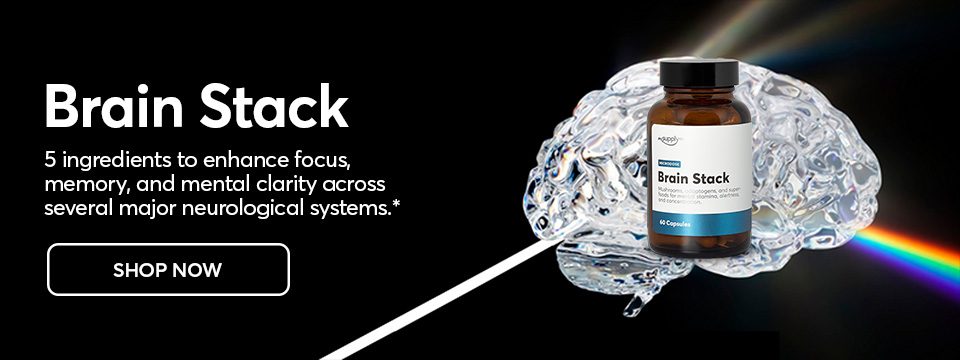


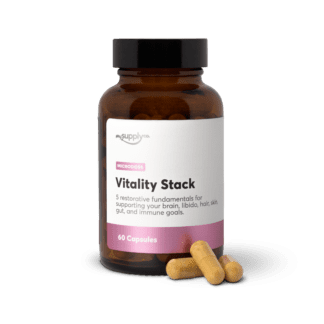
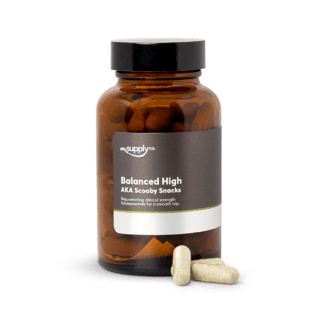
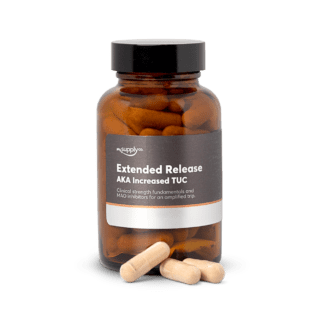
Thank you for this. It is wonderful that these natural alternatives to medication are now becoming available.
Very informative breakdown; especially for beginners!
Very informative
Gosh, this is such a helpful guide to dosages to help guide people to getting the results they want. Great info!
Awesome information. Thank you.
Looking forward to better understanding and use of product
Very helpful. Thank you
Fadiman 4 Life.
can't wait to try
This is great information. Super helpful. Have a great day.
Great information thanks.
I have always nervous to try, but this gives me a new understanding. thanks for sharing
They’re definitely a lot of fun but you have to be careful how much you take . It’s nice to have a guide .
This information may explain why I once had a bad trip with mushrooms. Thanks
The very last time that I did Macrodosing will be the last time.
Not for me, but for the adventurous it is best to be properly informed.
Microdosing seems to be the way
I'm interested to try this
Wow, this is an in-depth article on magic mushrooms and their dosing. I never knew there were different levels of microdosing, minidosing, macrodosing, and heroic dosing! It's really helpful to understand the effects of each dose and what to expect. The guide breaks it down into different categories, making it easy to choose the right dose based on experience and confidence. I appreciate the disclaimer that using mushrooms is different from using cannabis and starting on lower doses is recommended. This article is definitely a must-read for anyone interested in exploring the world of magic mushrooms. #magicmushrooms #dosingguide #psychedelics.
Very informative.
Super informative and useful information!
I can't wait to learn more from you and design my own wellness package too
My be better than what my Dr. prescribed.
I've tried once before, I cried too much.
This was so informative. It is wonderful of you to post this so that everyone can experience the results they are looking for.
Good information
Super helpful. Thank you for the Great Info, Cant wait to try this!
Imformative but no thanks
GREAT info. TY so much!
Very interesting article
Very interesting information! I can’t wait to try it myself!